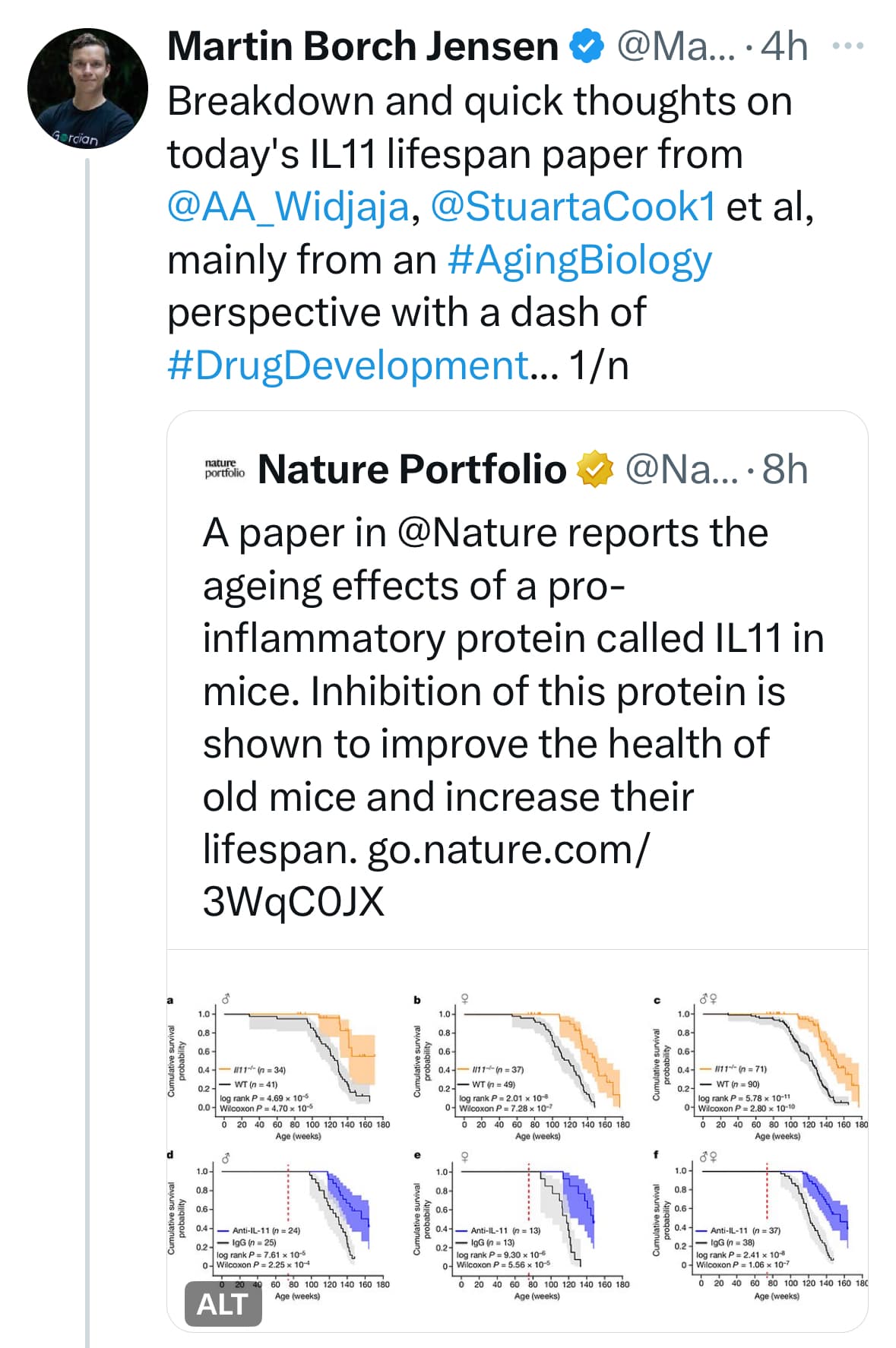https://x.com/jpsenescence/status/1813599355250565569?t=h_c6UQAC8oaA5ThSY3oHBg&s=19
From Linkedin:
35 minutes ago
Very interesting data showing that blockade of a pro-inflammatory cytokine, IL-11, can extend lifespan in mice by 25%. This seems to be related to multiple pathways include STAT3-IL6/IL8, AMPK-mTOR and others. We can test IL-11 levels in our lab for those who might be interested in this.s
Well, it says Rapa is an IL-11 inhibiter. But not how much for how long.
I’ve not seen evidence that rapamycin inhibits IL-11. I’ve seen evidence of the opposite. Rapamycin activates TGF-β, which activates IL-11. This is an undesirable off-target effect.
I have seen evidence it inhibits IL-17, which is great because all other interventions to lower or inhibit this require injection.
Rapamycin my not inhibit IL-11, but researchers have suggested that IL-11 may essentially work through the same pathways as rapamycin…
As reported, IL-11 inhibition may work through essentially the same pathways as mTOR inhibition. The degree of life extension is similar to that achieved via mTOR inhibitors such as rapamycin.
See: IL-11 Inhibition Extends Life Span in Mice by up to 25% – Fight Aging!
I wonder what happens if we combine rapamycin with an IL-11 inhibitor?
I also discovered that Omipalisib, the number 1 result on the Ora Biomedical MMC leaderboard discovered by Rapamycin Longevity Lab, inhibits TGF-β. This is likely great news.
I wonder what happens if we combine rapamycin with an IL-11 inhibitor?
I think we all want to see this experiment done, but the ITP wouldn’t use the anti-IL-11 mAb that was already shown to increase mice lifespan, as it almost certainly can’t be effectively administered via chow. The small molecules LMT-28 and FDA-approved bazedoxifene were shown to inhibit IL-11 (+IL-6 in the case of LMT-28), and would be more amenable to testing in the ITP.
Also worth mentioning is the evidence that metformin acts as a TGF-β competitive antagonist, see Metformin is a novel suppressor for transforming growth factor (TGF)-β1. Although metformin failed in the ITP in isolation, metformin+14 ppm rapa from 9 mo may be synergistic in males relative to 14 ppm rapa from 9 mo:
Although the current (C2011) cohort did not contain any mice given Rapa alone, we thought it would be of interest to compare the survival of mice receiving both Rapa and Met to survival of mice treated with the same Rapa dose in previous years, C2006 and C2009 (Miller et al., 2011, 2014). Results are shown in Table S4 (Supporting information). Males given Met/Rapa had a 23% increase in median longevity, higher than the 10% effect produced by Rapa alone in C2006 or the 13% effect in C2009 males. When the results from C2006 and C2009 males were combined for optimal statistical power, and compared with survival in C2011 mice receiving Met/Rapa, the difference did not reach statistical significance (P = 0.12) using our standard calculation, which stratifies by site. An alternate analysis, omitting site stratification, found P = 0.049 for the contrast between Met/Rapa and the historical datasets using Rapa alone at the same dose. Female mice given Met/Rapa also had a higher percentage increase in median lifespan (23%) than females that had received rapamycin alone in the previous C2006 and C2009 cohorts (18% and 21%, respectively), but the difference did not reach significance by log‐rank testing.
I think we need to clearly distinguish between drugs that directly inhibit TGF-β signaling at the receptor level (e.g RepSox, metformin, circulating α-Klotho), those that directly activate it (e.g rapamycin), those that indirectly modulate it by affecting the levels of bioactive TGF-β (rapamycin also falls into this category), those that modulate downstream pro-fibrotic intracellular signals like SMAD2/3 and YAP/TAZ, as well as those which modulate downstream pro-fibrotic extracellular signals like IL-11.
For example, there’s evidence that SGLT2i’s modulate YAP/TAZ signaling and they have anti-fibrotic effects in multiple organs. Empa/cana+rapa+acarb in the 2025 ITP cohort pretty please? ![]()
Does berberine have a similar effect to metformin in this regard?
The first time I took rapamycin I took it with berberine. Then I found it inhibits CYP3A4 which can make rapamycin more intense so I deliberately removed it from rapamycin days and I’ve had mouth sore every dose I’ve not added berberine. So strange.
We may only need to inhibit TGF-β1 (or downstream effects) a few days surrounding rapamycin intake to offset side effects.
I also had a thought of what if we took something that increased mTOR2 on the days we take rapamycin?
